

Teaching Ideas and Resources to Help Students Make Sense of the George Floyd Protests. Updated, June 8 “The anger is different this time.

After years of Americans being killed by the police — more than 1,000 per year, for as long as statistics exist — something has changed over the past week,” begins the June 2 “Morning” newsletter. It continues: The gruesome video of a Minneapolis police officer kneeling on George Floyd’s neck plays a role. So does a pandemic that’s disproportionately killing African-Americans.
Teachers know that this news and the issues around it need to be addressed. How Schools Can Support Student Activism — Sydney Chaffee. Student activists often stand on the front lines of social justice movements.
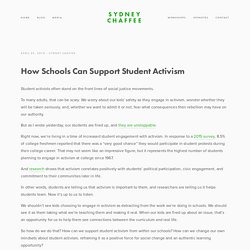
To many adults, that can be scary. We worry about our kids’ safety as they engage in activism, wonder whether they will be taken seriously, and, whether we want to admit it or not, fear what consequences their rebellion may have on our authority. But as I wrote yesterday, our students are fired up, and they are unstoppable. Right now, we’re living in a time of increased student engagement with activism. In response to a 2015 survey, 8.5% of college freshmen reported that there was a “very good chance” they would participate in student protests during their college career. Supporting Student Activism - School of Education - Loyola Maryland. From making TikToK and YouTube videos to creating podcasts and SnapChat stories, today’s youth draw on humor and pop culture to write their stories into existence through social media.
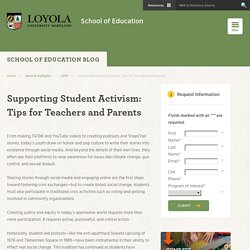
And beyond the details of their own lives, they often use their platforms to raise awareness for issues like climate change, gun control, and sexual assault. Sharing stories through social media and engaging online are the first steps toward fostering civic exchanges—but to create broad social change, students must also participate in traditional civic activities such as voting and getting involved in community organizations. Creating justice and equity in today’s oppressive world requires more than mere participation. Student Activism and Gun Control. Schools are experiencing a tidal wave of student activism in response to the shooting in Parkland, Florida.
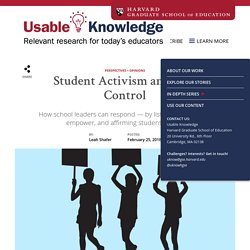
Practically overnight, Marjory Stoneman Douglas High School students have become the new face of gun control and school safety — challenging lawmakers, tweeting out their views, and organizing marches, boycotts, and walkouts for stricter gun laws. As young people across the country join in, it’s an inspiring moment for their educators — and a tricky one. Many feel powerless against state and federal laws, uncertain as to what their district leaders will endorse, unsure how to steer anger into action, or overwhelmed by a torrent of youthful voices. We spoke with Gretchen Brion-Meisels, an expert in youth development who studies ways to build a positive school climate. Responding to Student Protest. Guideline for Discussions. Tools for Productive Anti-Hate Dialogue – #USvsHate.
Morningside Center for Teaching Social Responsibility. Teachers often avoid "hot-button" topics because the issues are so complex, or because they don't feel prepared to handle the strong feelings and opinions discussion might stir.
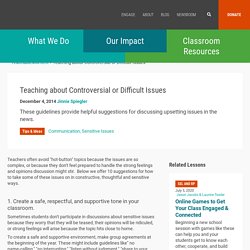
#USvsHate During School Closures. More Students Are Becoming Activists. Teachers Can Help Strengthen Their Voice. Clara immediately stood out as a different sort of high school student—and yet, she was a type of different I have started to spot more and more.
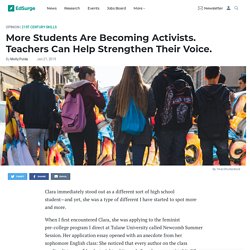
When I first encountered Clara, she was applying to the feminist pre-college program I direct at Tulane University called Newcomb Summer Session. Her application essay opened with an anecdote from her sophomore English class: She noticed that every author on the class reading list was a “dead, straight, white male,” as she summarized it. When she approached her teacher and asked why, he suggested that Clara take a “women’s literature” course if she wanted to read books by women. Undeterred, Clara submitted an alternate book list with greater diversity, but her teacher ignored it. Listening to Young People – Freechild Institute. In order to be adult allies, adults have to learn to listen to children and listen to youth.

Listening can be simple, painless and easy; it can also be complex, painful and hard. Either way, adults have to learn to listen to young people in order to get past just hearing what they said. This is how adult allies listen to young people. Helping Students Make Sense of News Stories about Bias and Injustice. When there are national news stories that involve incidents of bias and injustice, young people want to be part of the conversation.
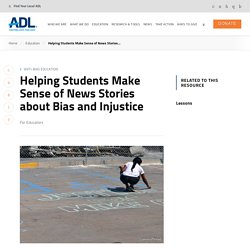
Even at a young age, they hear adults talking about what’s happening, read about the story on social media or learn about it through television. Rather than protect children and youth from what’s going on in the world, there are age-appropriate and constructive ways to engage them in understanding the situation. Teachers often feel a responsibility to address the issue in some way, whether they do it with a short conversation, an interactive lesson or a unit lasting days or weeks. This Book is Anti-Racist Teaching Guide for Educators. Student Protests: Questions and Answers. 4: I’m a principal.
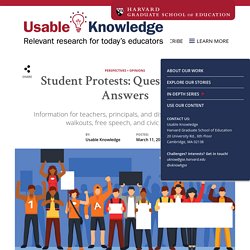
The students in my district want to participate in walkouts and marches for stricter gun control laws. How should I respond? Principals and superintendents face complex decisions: ensuring safety, ensuring the continuation of the educational program, and maintaining political neutrality, even as they also must support students’ right to expression. The National Association of Secondary School Principals offers a series of considerations for responding to student protests. 'Teachers Cannot Be Silent': How Educators Are Showing Up for Black Students Following Protests - Teaching Now. By Madeline Will and Sarah Schwartz Protests against police brutality have erupted across the country over the past three days, leading to tough classroom conversations about race, racism, and police violence.
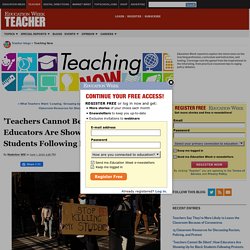
Teachers, already struggling to reach students during the coronavirus pandemic, are now searching for ways to help them work through their feelings about the protests and the police killings of George Floyd, Breonna Taylor, and other unarmed black men and women—without being with their students in person. The death of Ahmaud Arbery, a black man who was shot while jogging by two white men in Georgia earlier this month, has also inflamed national tensions.
It's a daunting conversation to have through a screen, many teachers said. The death of Floyd, a black man in Minneapolis who died last week as a police officer knelt on his neck for nearly nine minutes, has sparked national outrage. He messaged his students on the app Remind and told them he wasn't assigning any work this week. Questions and answers regarding student protests. This content is provided to ACSA by the Orange County Department of Education. You can contact their Legal Services Division here and download the original PDF here. 'This Is My City': How One Principal Supported His Students in the Aftermath of the Protests - District Dossier. It's been a rough month for schools, as Lee Buddy Jr., the principal of Wade Park School in Cleveland, well knows. He's been guiding his K-8 students and teachers through the abrupt shift to online learning.
Effective management student protests. From Zoom to the streets, students and schools find teachable moments in protests of police violence. Students have a right to protest, schools must respect it — CRIN. School students have led the way on climate protests in recent weeks and months, challenging the complacency of established politicians standing silently by while we move towards the point where it will be too late to reverse climate change. Walkout and Protest FAQ. RespondingToStudentProtests. Supporting Student-Led Activism. Can Students Protest During School? What Supreme Court Said. Taking A Knee: The Rights Of Students To Peaceful Protest. Silent protest is a longstanding tactic used to call attention to issues and highlight the need to address injustice. Such protests, including sit-ins at segregated lunch counters during the civil rights movement of the 1960s and today’s football players taking a knee during the national anthem, can produce powerful images and raise strong emotions.
When the silent protest is by a student – kneeling before the national anthem, refusing to stand for the pledge of allegiance – teachers and administrators often find that they lack guidance on how they can and how they should respond. There are two different questions at play. First, can school personnel discipline or reprimand a student for protesting? A school’s ability to do this is clearly limited by a student’s constitutional rights. The ACLU believes that both questions need to be answered, and is doing so in related advisories. The landmark U.S. . . . . This doesn’t mean that students are not subject to any restrictions.